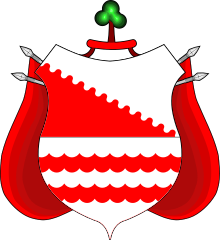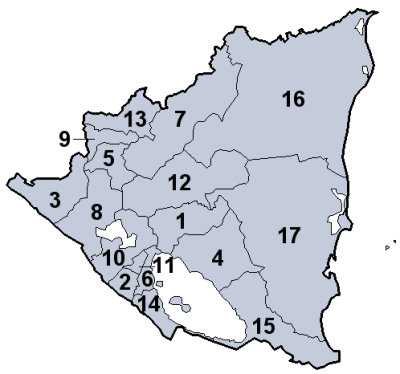Portal:Nicaragua
The Nicaragua Portal
Nicaragua, officially the Republic of Nicaragua, is the geographically largest country in Central America, comprising 130,370 km2 (50,340 sq mi). With a population of 7,142,529 as of 2024, it is the third-most populous country in Central America after Guatemala and Honduras. Nicaragua is bordered by Honduras to the north, the Caribbean Sea to the east, Costa Rica to the south, and the Pacific Ocean and shares maritime borders with El Salvador to the west and Colombia to the east. The country's largest city and national capital is Managua, the fourth-largest city in Central America, with a population of 1,055,247 as of 2020. Nicaragua is known as "the breadbasket of Central America" due to having the most fertile soil and arable land in all of Central America. Nicaragua's multiethnic population includes people of mestizo, indigenous, European, and African heritage. The country's most spoken language is Spanish, though indigenous tribes on the Mosquito Coast speak their own languages and English. (Full article...) Selected article - The Mosquito Coast (also known as the Mosquitia or Mosquito Shore) is an area along the eastern coast of present-day Nicaragua and Honduras. It was named after the local Miskito Nation and was long dominated by British interests and known as the Mosquito Kingdom. From 1860 suzerainty of the area was transferred to Nicaragua with the name Mosquito Reserve, and in November 1894 the Mosquito Coast was militarily incorporated into Nicaragua. However, in 1960, the northern part was granted to Honduras by the International Court of Justice. The Mosquito Coast was generally defined as the domain of the Miskito Kingdom and expanded or contracted with that domain. During the 19th century, the question of the kingdom's borders was a serious issue of international diplomacy between Britain, the United States, Nicaragua, and Honduras. Conflicting claims regarding both the kingdom's extent and arguable nonexistence were pursued in diplomatic exchanges. The British and Miskitu definition applied to the whole eastern seaboard of Nicaragua and even to La Mosquitia in Honduras: i.e., the coast region as far west as the Río Negro or Tinto. (Full article...) Did you know...
Related portalsWikiProjectsSelected image -SubcategoriesNicaragua newsThings you can do
Nicaragua TopicsDepartmentsNicaragua is a unitary republic. For administrative purposes it is divided into 15 departments (departamentos) and two self-governing regions (autonomous regions). (Department capitals in parentheses) Associated WikimediaThe following Wikimedia Foundation sister projects provide more on this subject:
Sources
Discover Wikipedia using portals | ||||||||||



































